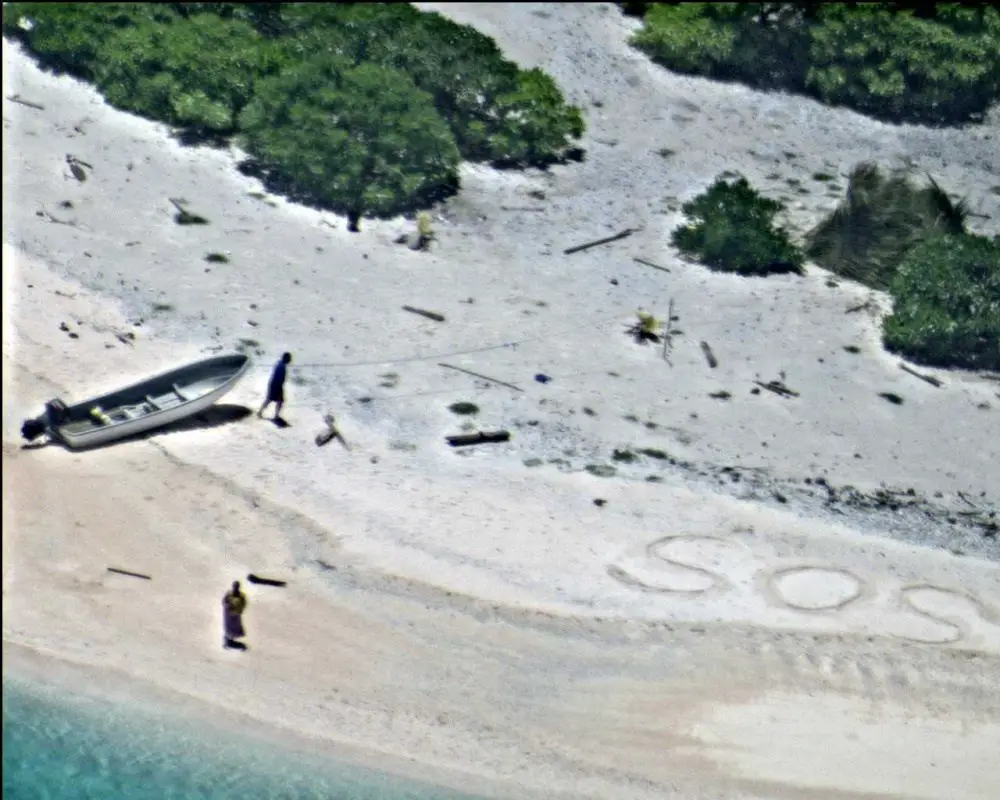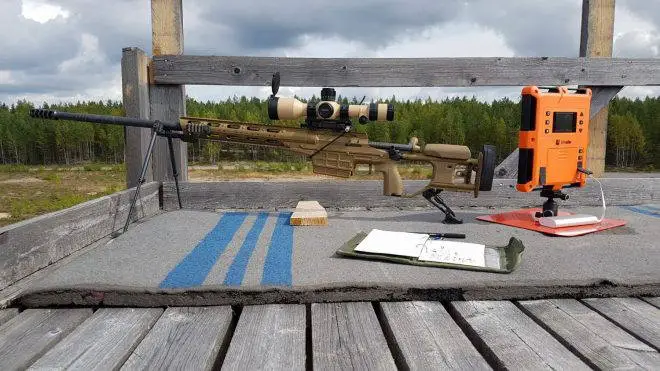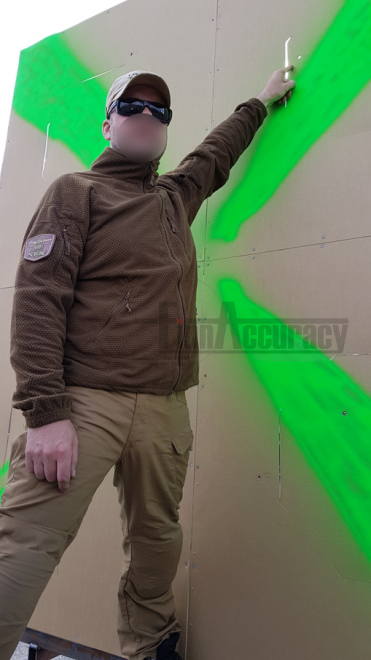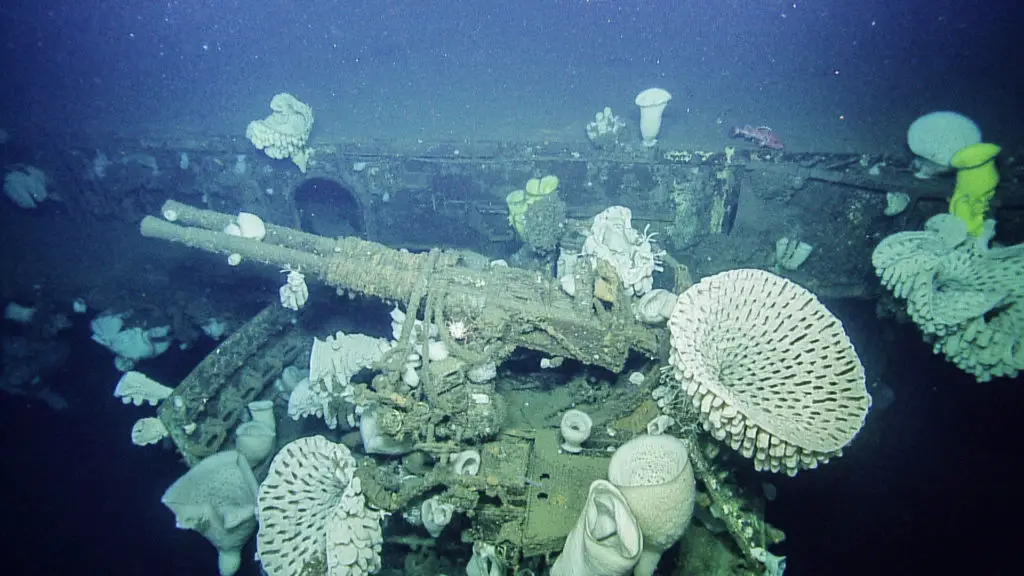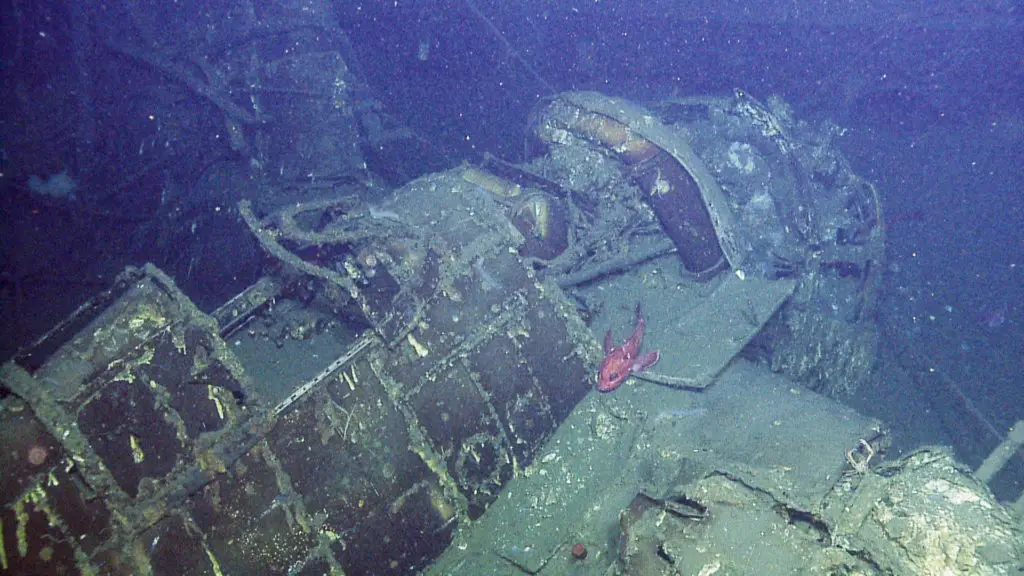Monthly Archives: August 2016
 Anything can kill a person, even things intended to be life-saving. An elderly Pennsylvania woman found out the downside of hanging a medical alert gadget around your neck — the hard way.
Anything can kill a person, even things intended to be life-saving. An elderly Pennsylvania woman found out the downside of hanging a medical alert gadget around your neck — the hard way.
Roseann J. DiFrancesco was found dead in her bathroom on Feb. 15, according to the report from the Cumberland County Coroner’s Office. Relatives had last spoken to her on Feb. 12.
She was found after a visiting nurse, unable to summon DiFranceso by knocking on the door, entered her home and found her. It was unclear how long she had been dead.
Cumberland County Coroner Charles Hall said the lanyard of the medical device, having caught on the walker, caused DiFrancesco’s upper torso to be suspended above the floor level, and the resulting pressure on her neck cut off air and blood flow.
Hall said the lanyard used by DiFrancesco apparently lacked a breakaway feature. But he didn’t know whether it was the lanyard that came with the device or a replacement.
Hall called the death a “freak accident.”
“Freak accident,” though, is not the same as “one-off.”
However, there have been injuries and a few deaths associated with such personal alert systems over the years. In 2009, the U.S. Food and Drug Administration issued a warning, saying it was aware of at least six serious injuries or deaths related to one of the popular brands of the device between 1998 and 2009.
Available from numerous makers, they often involve a pendant with a button the wearer can push to summon medical help in the event of a fall or medical emergency.
Some have break-away lanyards to prevent choking or injury if the lanyard catches on something or is otherwise pulled.
However, there has been disagreement over the benefits of breakaway lanyards, with some device makers saying the greater danger is that a lanyard will break and the alert device will be out of reach when needed.
Survival Approach: Trust to Luck (and Rescue)
A couple set out on 17 August 2016 to travel from one tiny island (Weno) to another (Tamatam), in the vast Pacific, in an 18-foot open boat. They landed on another island entirely, an apparently nameless, uninhabited island in Chuuk State, Micronesia. And there they waited to be rescued… for a week.
Their survival today is living (literally!) proof of the old adage, “It is better to be lucky than to be good.” They survived for seven days before being found, first by a passing ship which saw lights on the uninhabited island, and then by a US Navy patrol aircraft, which saw the “SOS” they’d drawn in the sand. The Navy snapped these pictures.
From that point, the rescue of the two marooned people was assured, although it took two more days (from Wednesday, 24 August, to Friday the 26th) for them to be picked up and delivered to safety.
Twenty-four hours after the two and their boat neither returned to Weno nor arrived at Tamatam, the Coast Guard was alerted. A seven-day search of 17,000 square miles came up dry (no pun intended), and the good fortune of a ship passing, and the survivors having a flashing light for signaling, made the rescue possible.
It’s a lot easier to list the things that these people did wrong than what they did right, but they did do a couple of things right — bringing a means of signaling was one, and leaving word ashore about their route and intentions was another. (We’ve heard the Coasties call this a “float plan.”) But this adventure came within a hair’s breadth of being, instead, one of those missing-persons mysteries that the vast Pacific produces every year.
So learn from what they did right and what they did wrong, when you’re out in open water.
The First Czechoslovak Service Pistols. Nº2: the vz. 22
The first Czechoslovak service pistol, the Praga, was developed by private industry. The first Czech-developed service pistol from the national arsenals, on the other hand, wasn’t really all that Czech-developed. It was designed by Josef Nickl of Mauser-Werke, and, in his honor, was often called the “N” pistol during its long and fraught development. A version very similar to the one that would become a Czech service pistol was put forward in Oberndorf in 1916 as a single-action 9mm Parabellum auto pistol.
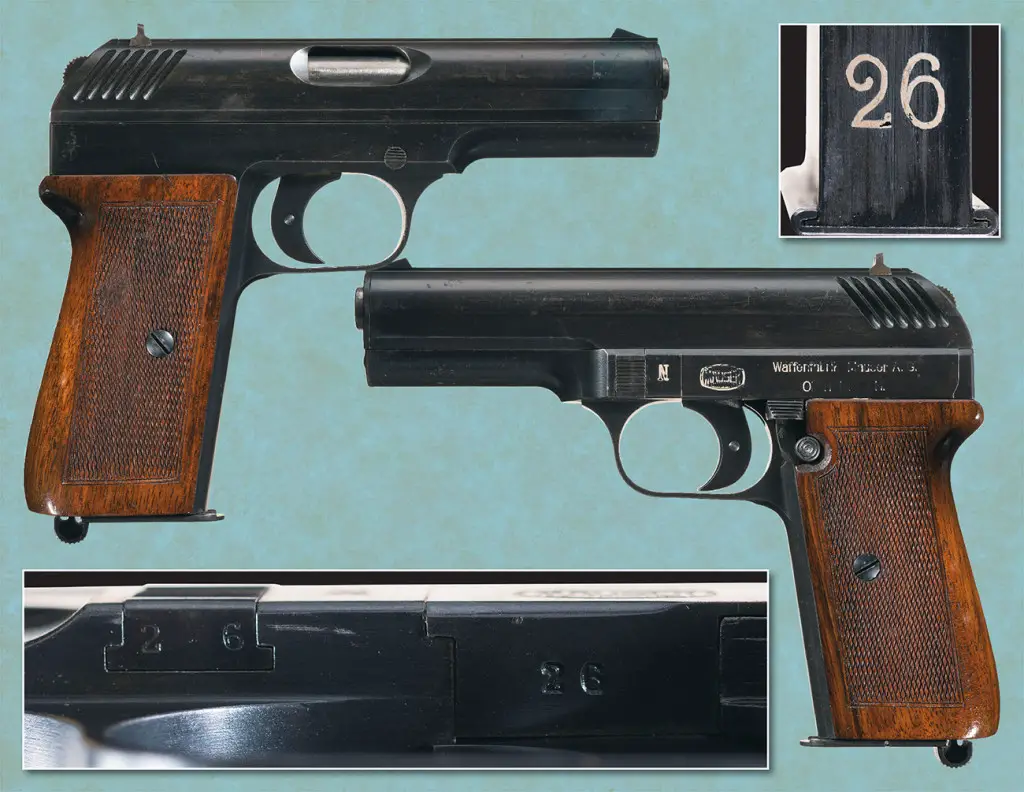
Nickl Mauser 9mm Prototype Serial Nº 26, auctioned by RIA in 2016. (Rock Island Auctions photo, used by permission).
This hand-crafted, tool-room prototype is, apart from its 9 mm chambering and size, a ringer for the Czechoslovak vz. 22 in many details, as we’ll see. In 1916 and subsequently, Mauser never put his pistol into production, but they let him pitch it to the Czechoslovak military while he was helping set up a production line for Mauser 98 rifles (which would be, confusingly, the vz. 22 and vz. 24 also!). The Czechoslovak Army tested both 9mm and, at their own insistence, scaled-down 9 mm Short (.380) versions. (This development was taking place, according to Col. Dr. Milan Šada, contemporaneously with the procurement of the Praga pistol in 7.65 mm).
The initial accepted version was the vz. (vzor, model) 22 for the cartridge vz. 22 (the 9mm Browning Short or .380 ACP, for all intents and purposes), and from the very beginning, the Czechoslovak Army had trouble with it. In time, they developed an improved version as the vz. 24. That in turn was developed into a 7.65mm pistol for police and export, the straight-blowback vz. 27. (We’ll use the Czech and Slovak word vzor, the official abbreviation vz., and the English word “model” interchangeably in this article. They all mean exactly the same thing and identify the model by year of adoption. Note that, unlike many nations where, say, Model 24s start appearing in 1925 or 26, Czechoslovak practice often had the guns in production before the year of adoption marked on them!)
One nice thing about Czech and Czechoslovak firearms (inherited from their Austro-Hungarian imperial masters) is that most of the firearms are dated with a proof date (civil weapons) or MOD acceptance date (military ones). Some weapons bear multiple dates, if they were (for instance) accepted by the military, and later proofed for surplus sale.
Model 24s are relatively uncommon, compared to the Model 27 which the Germans kept in high production after the occupation, but the Model 22 is more uncommon yet. Production numbers are estimated at: vz, 27 (and German Pistole Mod. 27), 590,000 (all but about 30,000 of them under the Nazis); vz. 24, 190,000 from 1923-37, possibly -39; vz. 22, about 19,000.
Several common strains in Nickl’s Mauser designs were united in this firearm: a single-action auto pistol with a breech locked by rotating barrel, like an Obregon or some Steyr pistols; and the unusual safety arrangement from the Mauser Model 1910, 1914 and (later) 1934 “pocket” pistols in 6.35 and 7.65mm. The safety has two buttons: One is activated with a sweep of the thumb to put the weapon on safe; the other instantly releases it with a press. Described like that, it sounds awkward, but is quickly learned and intuitive to use.
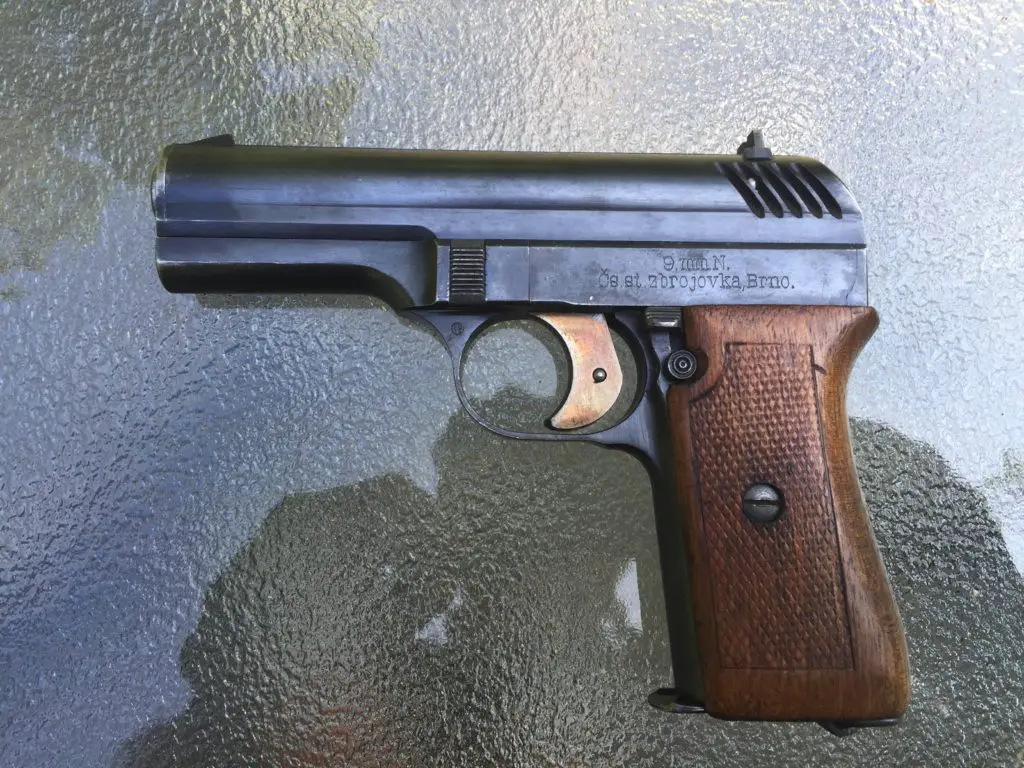
Left side of the same CZ 22. Note marking “9 mm N” and the second line, which translates to “Czechoslovak State Factory for Arms, Brno.” Is the N for Nickl (some of his Mauser prototypes are so marked), or does in just mean “Cartridge,” abbreviated? The Czech word for “cartridge” is “naboj,” pronounced NA-boy.
The overall size, shape and form of the vz. 22 and later CZ 24 and 27 pistols is very reminiscent of the 7.65mm Mausers, also. The side plate is similar. The frame rails are similar; the slide is similarly offset to the right, from the shooter’s perspective (although the barrel is centered on the frame), which is a peculiarity of the Mausers as well. The grips are similar.
Where the Nickl pistol departs from the earlier Mausers (in which the relative contributions of Nickl, the Feederle brothers, and other Mauser engineers are not entirely clear) is that the Mausers are striker-fired, and the CZs are hammer guns.
Prototypes of the Pistole N (for Nickl) were made in 9×19 mm as well as 9×17. The Czechoslovaks preferred the smaller cartridge (also adopted by other European nations, including but not limited to Italy and Hungary) and that was adopted as Naboj vz. 22.
The vz. 22 was manufactured at the Czechoslovak State Arsenal, Brno, and it is a rare Czech pistol to bear Brno markings on its slide. (Production of subsequent models would take place in a satellite factory in Strakonice, and after 1936 in Uhersky Brod, and many later pistols, regardless of where they were made, would be marked as if they had been produced in Prague, the corporate seat).
Changes from the Model 22 to the Model 24 were aimed at increasing reliability, increasing interchangeability of parts, and increasing production speed and lowering production costs. The Czechoslovak Army was bedeviled with reliability issues, and the extensive hand-fitting that makes them fit together beautifully makes them hard to replace parts in.
As mentioned above, the Model 22 is a rare pistol that is actually marked as having been made in Brno. Interwar Czechoslovak leaders had a touching faith in the power of central planning, and tried to run their arms industry on such a basis, reorganizing it several times during the short life of the Republic. They decided that Zbrojovjka Brno specialize in rifles (and, when it picked up Vaclav Holek’s MG design from Praga, light MGs); pistols would be made by Česká Zbrojovka’s factory in Strakonice (although they would often be marked “Praha” or Prague, the locaction of ČZ HQ), and over the years other plants would specialize in other weapons. After World War II some pistols would be marked with ZB trademarks (notably the ex-Dušek Duo pistol, the “Aut. Pistole ‘Z’,” but none of them would actually be made by Zbrojovka Brno.
The vz. 22 wasn’t the greatest pistol ever, but it was an important building block in the nascent Czech arms industry. Survivors, fairly plentiful, are prized today. It’s interesting to speculate what its position in auto pistol history might have been, had it been produced as Nickl originally intended, in the 9×19 mm service cartridge.
Sources:
(to be added).
Somber Sunday
This is one of those days when we’re overtasked. Last week we had a good if too-busy week, with an Army buddy hanging around while he punched a ticket at the SIG Academy, a new (and it turns out, very clingy) dog to learn and teach, and then our last surviving uncle was taken ill.
That kind of ill. The kind where they take you off the dialysis that has kept you alive for around a decade, and gradually disconnect the other contraptions and gadgets that are keeping a guy on the blade side of the grass.
His services are today; it will be our first experience of a Baptist funerary service, as everybody else has been Congregational, Catholic or Anglican. We shall comport ourselves decently. We hope.
He was a good guy who, with his wife, raised four good sons. He had been ill for a long time, but was in good spirits every time we saw him. We worry about his widow, the Blogfather’s sister.
Unfortunately, this day also had two other events scheduled: a family investment club meeting — already canceled — and a rare trip to Boston for a concert, a gift from the Blogbrother. That’s on the bubble. (Love the band, hate Boston).
Small Dog II is not liking being left alone. Came back from a bare one-hour bike ride today to find he had clawed most of the paint off the frame of the door he saw his human depart from. He also expresses his distress vocally. Fortunately Nice Neighbor Lady will come by and check on him a few times. (So one mission last night was to lock up the scarier looking guns, so as not to freak her out).
When Guns are Outlawed, Only Outlaws will have Knives

Luis Class, one of the few crims in the knife melee who was old enough to be named. Note the way he wears his shirt, and the look of keen intelligence — not.
The mayor says his city, New Bedford, Massachusetts, where guns are pretty much outlawed, “will not tolerate youth violence,” a nice euphemism for the gang activity that keeps the good citizens of the bad neighborhoods locked indoors.
For someone who doesn’t tolerate gang crime, he sure has a lot of it. Case in point, a gang melee that left a 15-year-old dead and a bunch of his friends and enemies in cuffs:
The slain teen was identified yesterday morning as Mateo Morales by Bristol District Attorney Thomas M. Quinn.
In addition, a 16-year-old juvenile male has also been charged with assault and battery with a dangerous weapon, Quinn said.
Police say Morales was already dead when they arrived at Middle and Chancery streets shortly after 6:20 p.m.
Two other male stabbing victims, ages 16 and 22, were treated for minor injuries.
They’ll get a quick cycle-around in the gentle Massachusetts courts, and be bagged for their next crimes of violence within five years.
Meanwhile, the Attorney General can’t make up her mind (if this guy is Class, she is No Class, same blank expression) about whether .22 rifles should be banned or not. And she does nothing to fight violent, drug, and gun crime. In case you were wondering why MA more than doubles the per-capita homicides of demographically similar NH.
Of All the Rangers to Get Killed….
 No disrespect to the illustrated Ranger, SSG Avonye Chisolm. But he could have been in a pretty safe job — he was a kid with a GED who joined the Army to be a Culinary Specialist, which is what the bureaucracy calls a cook. Thousands of kids do that every year.
No disrespect to the illustrated Ranger, SSG Avonye Chisolm. But he could have been in a pretty safe job — he was a kid with a GED who joined the Army to be a Culinary Specialist, which is what the bureaucracy calls a cook. Thousands of kids do that every year.
But… if you look at the image, you’ll see the rare combination (but fully earned on his part) of the tan Ranger beret and cook’s whites. Because he wasn’t content to sit in a mess hall (“dining facility”) and sling hash through the boring expedient of opening tray-packs.
He volunteered, and took on a challenge, and kept volunteering. Five times he went overseas to Operation Enduring Freedom. He attended the tough Ranger Assessment and Selection Program (RASP-1) with a cohort of would-be Rangers from combat and support specialties alike, and completed the course. (A continuation, RASP-2, is demanded of combat leaders only).
A U.S. Army Ranger died as the result of injuries sustained during an airborne proficiency jump August 24 at Galahad Drop Zone. Staff Sgt. Avonye John Cavon Chisolm, 26, sustained serious injuries during the airborne operation; he was transported to the nearest military treatment facility; then air-lifted to Memorial Health University Medical Center, Savannah, Georgia. He died August 25.The incident is under investigation. Chisolm was assigned to Company E, 1st Battalion, 75th Ranger Regiment, at Hunter Army Airfield, Ga., as a Culinary Specialist Non-Commissioned Officer.
via U.S. Army Ranger died during training | Article | The United States Army.
He joined the Army in 2008, and volunteered for the Rangers right out of school. He appears to have had no assignments other than the 3rd Ranger Battalion and the 1st Battalion.
For a young guy, he liked going to leadership and logistic schools:
His military education includes the Basic Airborne Course, Ranger Assessment and Selection Program 1, Basic Leader Course, the Unit Prevention Leader Course, Lean Six Sigma Course-Black Belt, Lean Six Sigma Course-Green Belt, Demonstrated Logistics Course, the Advanced Leader Course and the Culinary Skills Advanced Course. He was a certified ServSafe Food Protection Manager.
The jump accident that took his life is a reminder that even the support guys in SOF are expected to keep these qualifications and currencies up, and that, as safe as the military has made things like parachuting (“relative safety”), it hasn’t made it “safe” at all (“absolute safety”).
His battalion commander, LTC Robert S. Brown of 1/75, had a powerful statement:
Staff Sgt. Avonye Chisolm represented the best of our Ranger leaders. He had an impact on every Ranger in this Battalion through his tireless work ethic, positive attitude and contagious smile. He made us feel like we could shoulder more than our fair share of the task, because he always led from the front. His loss will be felt across the organization and our thoughts and prayers are with his family during this difficult time.
One hopes his grieving family will find some comfort in the pride they can take in that statement.
And one hopes Chisolm’s soul will find eternal rest.
Amazing Long-Range Shot: 4,000 meters
That’s roughly 2 1/2 miles. Now, a few caveats are in order: the shooters had considerable equipment, they were shooting at a target larger than man-sized, and they had one hit (#3, they’re pretty sure) out of four shots at that range. Still, that shot is amazing.
Erik B at The Firearm Blog has a long report and, if you’re interested in LR shooting, it’s incumbent on you to Read The Whole Thing™. A tiny taste of his 3k-plus word report (which seems to be first hand by the shooters, and is much more detailed than the write-up on their Facebook Page). They started at 100 m to establish zero:
375 Cheytac zero was done with five shots. Scope turret bottomed to zero, impact was 26.8 mrads high. Last two after windage adjustment were very close each other. This elevation was used as base for further calculations, as zero POI offset value in ballistic application. Just before shooting started, I found out that my bubble level was sitting on table back home. This was serious setback. During both zeroing and shooting, reticle and rifle must be in absolute vertical level. This was difficult, as there wasn’t horizon reference visible. Velocities were compared constantly, with each and every shot.
Then to 1000 m to confirm zero. Then to 3000 m. They ran into problems with ranging binoculars (Steiner & Vextronix) “stalling out.”
Shot count was 15 when we got everything finally sorted and good hit on target. Good meaning that everything matched. That particular shot MV (MV = bullet muzzle velocity) was same we used on ballistic software and actual elevation adjustment matched perfectly to QTU firing solution on same time. Also most importantly and with that particular shot, I knew shot was good. As mentioned, maintaining readiness and bubble where it should to fire in 1-2 seconds after permission from ballistician-on-duty was extremely cumbersome thing to do.
Consistent muzzle velocity is key. Their loads were within a small range, but a 1 m/sec change in muzzle velocity causes an 80 cm vertical shift in impact point — meaning 1 fps change alters that impact point almost 10″ in the same direction. So you see that firing at 4000 meters is really at the ragged edge of what’s possible with field-employable sniper-type equipment, in 2016. At 4000 m:
[T]arget was fine-positioned and checked for clear line of sight, and first time I realized how long distance it actually was. It was far, ridiculously far. Very hard to even see with bare eye, but surprisingly still ok visible with 3.7x (or so) magnification. Target was ok, and we received permission to shoot.
Third, or possibly, fourth, shot was heard to connect by a forward observer.
Yeah, it’s not people-shooting precise (or hunting practical) yet, but the journey of a thousand miles (or 4,000 meters) begins with a single step.
The guys behind the shot are the Finnish precision-shooting shop and school, FinnAccuracy. They report on the conditions of the shot on their FB page:
Athmosperic conditions, Vaisala + Kestrel used:
– 22C / 71.6F. RH 78%. 996mbar / 29.41 inHg
– Worth mentioning also Labradar velocity radar. It worked like a charm and really eased things up during actual shooting. Precise MV knowledge is everything with such a long flight times.
– Bullet flight time to 4000m = 11.2 seconds. Gyroscopic spin drift + Coriolis effect only shift bullet approximately 8 meters / 9yds at 4km distance.
– Ballistic calculations done with Quick Target Unlimited
The reason that they think #3 was the money shot is because its MV was closest to their calculated value. #4, the other possibility, had a slightly higher MV on the radar, which they think put the round over the target. They have high confidence in the Canadian-developed LabRadar, which claims a 0.1% accuracy.
Stay tuned – we might have someting in mind for future too.
They were only half way through their planned range session when they scored the 4,005 m shot, and they have extensive manufacturer support from Sako (maker of the gun) and Lapua (whose Scenar bullets they used in .375 Chey-Tac handloads). They had previously said they have further ambitions in long range shooting, but…
It hs been a long way and we would like to do more like this- but we also have optics/accessory business to run.
It’s true that a shooter 2½ miles out is not out of the reach of an enemy’s organic weaponry (mortars, artillery, tank main guns) but his signature even in the open is going to go unmarked by people in his target area. While this is a long way from being a practical sniping distance, at this time, when FinnAccuracy started off they were connecting at 2,000 m with .338 Lapua Magnum and that was a long way from being a practical sniping distance, then.
Friday Tour d’Horizon, Week 34
This week’s Tour d’Horizon is where we dispose of a week’s worth of open tabs, or try to. It’s gun-light this week.
Guns
I don’t wanna work, I just wanna bang on my gun all day. We lead with some Glock-heavy stories this week.
Wilson Combat Glock Barrels — an Appreciation
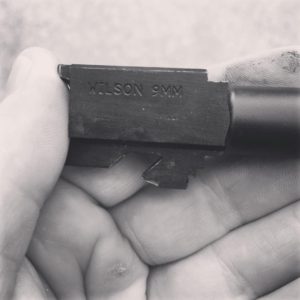 We’re not getting 100% of the accuracy potential out of our pistols. But some people are, and where do they go from there?
We’re not getting 100% of the accuracy potential out of our pistols. But some people are, and where do they go from there?
Kyle DeFoor, who has since reverted to shooting Glocks with stock factory barrels, highly recommends Wilson’s custom barrels (the kind that must be hand-fitted). Quoth KD:
To date the Wilson Combat hand fitted barrel is the most accurate I’ve seen for Glocks (yes, I’ve tried all currently out there). This is mine for my 17 I’ve had for 7 years. I’ve installed a number of them on the range for students, not hard once you get the hang of it and hand fitted will always outperform drop in if you know what you’re doing.
How good is it? It’ll damn near cut your group in half at 25 yds. Pair it with match ammo and it will get even tighter. Know that it will not help you with accuracy if you don’t have solid fundamentals down already, but it will absolutely benefit those that are there and should be considered for anyone who needs an added edge in competition or work. Additionally it’ll eat any kind of shit ammo you cycle into it in my experience.
So, if the Wilson’s so great, why did he go back to factory stock barrels?
So why don’t I use one anymore? Simply to show students what’s possible with bone stock issued Glocks and a solid grasp of shooting skills.
Fair enough. And yes, Wilson makes them in threaded. (And no, Kyle doesn’t have some deal with them, and neither do we). The Wilson barrels have conventional broached rifling, not the polygonal rifling hammer-forged into the Glock. Wilson believes that the stock rifling is prone to pressure spikes.
Experience: Glocks in a Special Mission Unit
A funny thing happened when most of the shooters in a special missions unit previously in love with the M1911 transitioned to .40 caliber Glocks. All appreciate the Glock’s reliability, durability and reduced downtime, and most of them shot better — except for the very best shots. They found that tighter overall groups have been challenged by random flyers.
The problem is, apparently, that the Glock generally shoots a really tight group, but will occasionally throw a random flyer that can’t be explained or tuned out of the guns (or, perhaps, ammunition). This happens every ten shots or so. There’s been a lot of talk about it, but nobody (including Glock) has a cause, let alone a solution, and not everyone believes that there’s a problem. (Wilson’s pressure-spike theory may fit here). The guys that are consistently shooting 9 out of 10 rounds into a 2″ circle and occasionally shooting 1 out of 10 into a 6″ circle don’t think it’s them.
These guys have some missions where inches really count. And so far they’re sticking with the Glock, because the pros outweigh the cons (in logistics, too, everything is a trade-off).
Maybe they need their armorers to fit some Wilson barrels?
SF Gives Up on Joint Service Pistol, buys Glocks
Meanwhile, “White” SF has bought a bunch of Glock 19s with MFP-11 special operations money. Why? Because they got tired of the delays and incompetence in Big Green’s (and the Joint blob’s) new service pistol program, and the options were to fight Big Green for new M9s to replace shot-out guns (the Army’s definition of “serviceable” is pretty loose), or just throw the SOF credit card down on the table. Think of it as an end-user vote of no confidence in the joint service pistol program.
Ironically, the new Glock 17M that’s been in the news lately seems to be responsive to the Joint Service Pistol requirements (notably, increased ambidexterity and deletion or finger grooves).
Insider consensus seems to be that the project has done nothing but waste scores of millions of dollars, and they doubt that it will produce anything except promotions for the clowns that have mismanaged it.
No word on whether the credit card gives double points.
Smith & Wesson: What’s M2.0?
 Soldier Systems Daily found an interesting trademark filing from the Massachusetts firm: “M2.0” with rather vague terms about what it might apply to.
Soldier Systems Daily found an interesting trademark filing from the Massachusetts firm: “M2.0” with rather vague terms about what it might apply to.
Next generation of the M&P striker fired pistols? That’s one guess. What’s yours?
Could New Jersey go Shall-Issue?
The possibility arises with a conditional veto by Governor Chris Christie of language intended to firmly codify the legally shaky de facto “no-issue” policy which stands on a “justifiable need” standard. The NJ standard (and most jurisdiction’s, when they use this term) is modeled on the old “literacy test” of Jim Crow voting laws — whether you passed or not was a question, as the saying goes, “of men, not of laws.” In other words, if you can’t ever threaten a cop’s career with a loud and rude, “Do you know who I am?!?” then, you can’t possibly have a justifiable need; and if you’re “connected” (in one or the other meanings of the word — it is New Jersey, after all) you can’t possibly not have such a justifiable need.
Don’t get too worked up about this. The NJ legislature might still override Christie’s veto. It still marks a remarkable change of heart for a man whose career began with enthusiasm for banning guns. All a politician needs to come to Jesus, perhaps, is a political near-death experience. Or perhaps his thinking has evolved along with many legal scholars’ over the last several decades. In any event, friends and allies are where you find them.
Usage and Employment
The hardware takes you only half way. The wetware in your brain housing group is what makes your weapons work.
Deconstructing Terrorist Bombings
Greg Ellifritz has been on a roll lately, and he examines recent terrorist bombings in Thailand (targeting tourists, you may not have heard of these) and Canada (the self-radicalized and self-detonated splodydope who was in the news). There’s a lot of meat in the article, but here’s a few bullet points that struck (no pun intended) us.
- Thai police knew about the plot, but kept mum to prevent panic. Pretty normal cop behavior, he notes.
- The Canadian jihadi planned a small arms and bomb attack on people stuck in rush-hour traffic.
- Terrorists in the USA have preferred guns to bombs, mostly; Greg thinks that’s just availability, and any gun restrictions may simply tip the terror balance in the direction of using more bombs.
- He calls them “ISIS-inspired” bombings, but if it wasn’t ISIS/ISIL, it’d be some other mohammedan act of worship.
There’s a lot more going on, but we can’t put everything in every week!
Wedged in Late: Cops Shoot Homeowner
Tam has the story from her own little slice of Indian Territory. Basically, attempted carjacking leads homeowner to (1) call cops (2) gun up and (3) pursue suspect. Can you guess what happens next?
Read The Whole Thing™, especially the Lessons Learned. Surely the parenthetical note in LL #2 is not aimed at Your Humble Blogger. At Ian, maybe.
Cops ‘n’ Crims
Cops bein’ cops, crims bein’ crims. The endless Tom and Jerry show of crime and (sometimes instantaneous) punishment.
“Stand down, Let them Beat the Trump Ralliers.”
The Minneapolis Police Department is denying that’s what they ordered, but there’s one problem with their denials: that’s what they actually were seen to have done. Minneapolis cops turned their backs while Black Criminals’ Lives Matter rioters assaulted people leaving a rally. The cops, perhaps through their union, had coordinated with paid protesters and only intervened when someone was actually being injured.
Tellingly, in those cases, all they did was tell the rioters to stop — and they did.
Lots and Lots of Cop-Involved Shootings
It’s a shooting gallery out there. Too many to list (going both ways, unfortunately). We may have something on that this week.
Now THIS is a War on Drugs
 In the Philippines, President Rodrigo Duterte is waging war on drugs — complete with a drug dealer body count. This has the American media, for most of whom “drug user” calls up warm undergraduate memories, up in arms. Time Magazine (that’s still around?) calls it The Killing Time, and complains that, “the real threat to the Philippines is not drugs but the President himself.” (They do use the dishonest writer’s “some say” dodge to slip in this personal opinion). The Washington Post made its pro-drug poster child (literally) a kid killed by vigilantes who were whacking a dealer who’d just been through the revolving door. Reuters complains that about 36 people, mostly drug dealers, are getting whacked every day, 1,900 so far (Reuters is rounding up from 1,850; American newspapers are already inflating it to 2,000). Of these, 750 have been shot by cops, and the rest are under investigation. But you have to go nine paragraphs deep in the Reuters report to discover that 700,000 other drug dealers and users have turned themselves in, and that, with all these criminals off the street, all crimes apart from the drug-vigilantism related homicides are down.
In the Philippines, President Rodrigo Duterte is waging war on drugs — complete with a drug dealer body count. This has the American media, for most of whom “drug user” calls up warm undergraduate memories, up in arms. Time Magazine (that’s still around?) calls it The Killing Time, and complains that, “the real threat to the Philippines is not drugs but the President himself.” (They do use the dishonest writer’s “some say” dodge to slip in this personal opinion). The Washington Post made its pro-drug poster child (literally) a kid killed by vigilantes who were whacking a dealer who’d just been through the revolving door. Reuters complains that about 36 people, mostly drug dealers, are getting whacked every day, 1,900 so far (Reuters is rounding up from 1,850; American newspapers are already inflating it to 2,000). Of these, 750 have been shot by cops, and the rest are under investigation. But you have to go nine paragraphs deep in the Reuters report to discover that 700,000 other drug dealers and users have turned themselves in, and that, with all these criminals off the street, all crimes apart from the drug-vigilantism related homicides are down.
Maybe Ryan Lochte Told the Truth?
If you don’t know who the hell that is, we wish we could trade skulls with you. For the contingent from Rio (Linda), Lochte is some kind of Olympic champion swimmer whose post-Olympic career of endorsements and appearances imploded because he supposedly lied about some drunken hijinks in Rio (de Janiero). But Lochte just may have told the truth, consistent with his level of inebriation, and the Brazilian cops may have lied.
See this article by Derek Hunter at the conservative site TownHall.com, or this one by David Meeks and Taylor Barnes at the liberal USA Today. Meeks and Barnes in particular have a well-reported story (Hunter seems to riff off their work), and it doesn’t match the headlines at all.
The Perils of Kathleen: Thought This was Over Edition
Here’s where we chronicle ongoing meltdown of the paranoid, vengeful and extremely anti-gun now-former Pennsylvania attorney general, Kathleen Kane. Last week we reported on her conviction and said, “we expect this to be our last regular update on Kane.” We misjudged her penchant for headline production.
- 25 Aug: The Porngate Report Will Not Be Released — at least, not for now. The report on which users of PA state court and justice information systems had exchanged off-color emails was created by Kane as part of her defense.
- 24 Aug: Law Prof: Professional Exile will Follow Prison Time for Kane. From his pen to the judge’s ears. He expects she will get a short stint in the state pen; while her conduct has earned her 28 years, no lawyer — and judges are lawyers first — would sentence another lawyer to that. Those sentences are for the muggles.
- 24 Aug: From the same Forbes article we learned that She Was Rated “Nation’s Worst AG” in 2015, not just because of these charges but also for retaliation against honest subordinates, and crony contracts that stank of corruption[.pdf]. The non-profit that rated her “worst” points out that they had determined her position prior to her indictment; that was just icing on the cake.
- 20 Aug: A retrospective on The rise and fall of Kathleen Kane in The Allentown Morning Call covers the basic history of her ascent to the job and the scandal that unseated her, and answers the question of why the media never vetted her: she was a Democrat, and therefore on “their team.”
- The key graf in the 20 Aug story is probably this one, tagged on at the very end:
Kane’s legal problems won’t end with her sentencing. A Pennsylvania House of Representatives subcommittee is continuing its impeachment inquiry. The state Ethics Commission is investigating her behavior. And in divorce court, she and her estranged husband are squabbling over more than $1 million from a depleted bank account.
Kane was wealthy, before she squandered her fortune (and perhaps as much as a million of Pennsylvania taxpayers’ money) on her quixotic legal defense, but the money was always her husband’s, a man of no visible talent who inherited a trucking company, Kane is Able.
Kane’s destruction of the family fortune falls into line with her destruction of the Attorney General’s office — and her own political and legal career.
The Cop was a Gun Crim UPDATE
Last week in this space, we mentioned Officer Thomas Abrahamsen of the San Francisco PD, charged with building an illegal AR-15.
Turns out, it wasn’t building the gun alone that did him, it’s that he did it in .50 Beowulf, a caliber specifically banned in the criminal-friendly, gun-owner-hostile, state. Needless to day, the guy behind the ban was the anti-gun, and pro-criminal (perhaps because he’s had several photo finishes with the FBI himself: 2013, 2014, 2015) Kevin de Leon, whose name also seemed to come up a lot in the Leland Yee (now in prison) and Ronald Calderon (ditto) cases (De Leon took a $5k bribe from the same bribe-payer — an undercover FBI agent — that slipped Calderon $88k). Naturally Yee and Calderon, convicted criminals, shared De Leon’s anti-gun policy position.
Unconventional (and current) Warfare
What goes on in the battlezones of the world — and preparation of the future battlefields.
Statue Rededication
We had the story back in 2012 when they moved the America’s Response statue (informally called De Oppresso Liber or The Horse Soldier) to New York City, but on 13 Sep 16 it’s going to be rededicated in its permanent setting.
A number of SF VIPs and luminaries are expected to be at the rededication. Former clerk-typist and legend in his own mind Rudi Gresham is not among them.
Air Force Caught Cooking A-10 Books
Shocked, we’re sure. The GAO has reported, in careful, lawyerly Washingtonian terms, that the USAF’s decision to scrap the A-10 was taken a priori, without a thought as to what requirements the A-10 and its dedicated community of CAS (and CSAR, and several other missions) pilots currently fulfill, let alone as to how the Air Force is going to fulfill them with a handful of F-35 hangar queens that also have to replace a much larger F-15 and F-16 fleet.
While A-10 pilots are recognized as the Air Force experts in providing close air support (CAS) to friendly forces, the A-10 and its pilots also perform other missions that are important to ongoing operations or to combatant commander operational plans and divestment will result in reduced capacity and capability in these other areas.
As you might expect, in a military problem, it’s a leadership problem; the USAF is rotting from the head.
[T]he department does not have guidance to ensure that the services and DOD are collecting quality information to inform divestment decisions on major weapon systems before the end of their service lives. Without quality information that fully identifies gaps and associated risks resulting from divestment that can be used to develop mitigation strategies, DOD and the Air Force may not be well-positioned to best balance current demands and future needs.
The Air Force has identified no replacement for the A-10 in CSAR missions. The A-10 replaced the A-1D and A-E Skyraider as “Sandy” CSAR cover aircraft; with its high minimum speed and almost nonexistent loiter time, the F-35 has no real prospect of performing this mission, suggesting that the Air Force is so willing to unload the A-10 — principally to free up money for the F-35 — that they’re willing to jettison the idea of rescuing downed pilots in future conflicts.
Full GAO .pdf: http://www.gao.gov/assets/680/679205.pdf
Veterans’ Issues
Is it time to disband this thing yet, and letting all its bloatoverhead seek its own level in the Dreaded Private Sector™?
Guess Which One they Fired
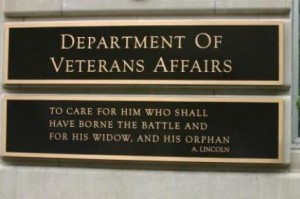 In Los Angeles, VA van driver Anthony Salazar reported to his supervisor, motor pool chief Robert Benkeser, that someone was abusing DVA credit cards for personal purchases — and, more seriously, that 30 of the 88 vehicles that were in the motor pool on paper, were not physically present.
In Los Angeles, VA van driver Anthony Salazar reported to his supervisor, motor pool chief Robert Benkeser, that someone was abusing DVA credit cards for personal purchases — and, more seriously, that 30 of the 88 vehicles that were in the motor pool on paper, were not physically present.
You know where this is going: manager Benkeser, a $141k a year (not counting bonuses and benefits) VA bosses’ insider, and the individual who probably profited from the missing cars, got a toothless “letter of counseling,” and Salazar got the sack.
The Office of Special Counsel (note .pdf) filed an amicus brief in support of Salazar’s appeal, but at present Benkeser is still cashing checks, and Salazar still isn’t. The Merit Systems Protection Board, in an apparent attempt to suppress whistleblowing, has ruled that whistleblowers have an extra evidentiary burden relative to mere litigants.
It really hurt Salazar to lose his job — the VA was paying him $70k as a driver/supervisor. He’s not going to get that from anyone else. One more data point for the dysfunction and incompetence in VA management.
Is it time to disband this thing, yet?
Lord Love a Duck!
The weird and wonderful (or creepy) that we didn’t otherwise get to.
It Takes Lots of Schooling to Get this Stupid

Penn coat of arms. The fish stands for the parents who send their sons and daughters to this place, and pay scores of thousands annually to do so.
The University of Pennsylvania is not the admit-nearly-anybody state party school that most “University of [State Name]s” are (that would be Penn State, home to the Jerry Sandusky of climate science and the real Jerry Sandusky, both). University of Pennsylvania is an Ivy League snob school, and you know what that means: really nutty professors. The latest crusade from Penn: we must liberate zoo animals from the crushing tyranny of being one of two sexes.
Save the gay crossdressing alpacas, apparently.
This Death To Biology™ study, paywalled at some obscure pseudoscience (social psychology) journal, is credited to a critter named Betsie Garner (well, we can’t very well call it a “woman,” can we, in the light of its research interests?), and a carbon-based life form named David Grazian (same objection, except what it isn’t is a “man.”)
As is usual in the pseudosciences, the entire paper stands on a very high coil of steaming theory, with relatively few data points to support the professors’ crusade. How few? We didn’t believe it, on first read of the abstract.
We draw on public observations conducted in a zoo to identify three instances…
Public observations? Yes, if you take your kids to the Philly zoo, these perv profs may be scoping them out. Hmmm…. maybe it’s not Penn State that has the bigger short-eyes problem.
First, adults attribute gender to zoo animals by projecting onto them human characteristics associated with feminine and masculine stereotypes.
Um, animals (and humans) have sex, not “gender,” a word that means what confused people think it means from moment to moment. Some of these confused people have been so unable to function in society that they’ve been forced to stay in colleges long enough to receive PhDs, the poor things (two cases in point, here).
[A]dults mobilize zoo exhibits as props for modeling their own normative gender displays in the presence of children.
Oh, for Christ’s sake. What they mean is, “that lion is a male.” Or, “See how the Gorilla mother holds her baby.” Can’t have that! Omigawd, we’ve traumatized the kids by breaking their isolation from biology. How will they ever learn about the nonexistent womyn gorillas who would rather date other she-gorillas and go to Ranger School?
What do these two losers want?
In emphasizing the context of the zoo as a site for the naturalization of gender categories, we identify how adults transmit gender socialization messages to children that promote gender stereotypes associated with the biological determinism of the natural living world.
The two of them, whatever they are, need to get their genderfluid checked. It’s at least a quart low. Our only hope is that the contract Penn signed with Professor Rescue when they adopted these two losers, requires the institution to have them spayed and neutered — given their confusion, probably both, each.
Hat tip, Emily Zanotti at Heat Street, who seems to think it’s as stooopid as we do.
New Video of the Sunken USS Independence
This video, from Wired, is pretty good because it shows a 40mm dual-mount AA…
…and one of the F6F Hellcats on the hangar deck.
On to the film:
The ship earned a lot of battle stars — and then got nuked. Twice. And still took some sinking. Now it rests on the seabed off San Francisco, for all time. It has become a curiosity for scientists studying, among other things, the long-term effects of a short, sharp dose of ionizing radiation.
When Guns are Outlawed, Only Outlaws will have Gators (again)
 Nice lizard. Niiiiiice lizard….
Nice lizard. Niiiiiice lizard….
CHOMP.
(How many times have we done gators, anyway, now? Four?)
They tried to reattach the lady’s hand.
A Central Florida woman underwent two surgeries, hours after, officials said, an alligator nearly bit her hand off in the Everglades, in Northwest Broward.
Broward Sheriff’s Fire Rescue officials said 49-year-old Kimberly Anne Sexton was bitten in the hand at Willards fish camp, a remote area west of Coral Springs, Friday evening. “She was standing on the dock, dropped a can into the water, and as she reached in to retrieve the can, that’s when she was bitten by the alligator,” said BSO spokesperson Mike Jachles.
Jachles said Sexton’s right hand was nearly severed as she reached for an empty Mountain Dew soda can. “She sustained a severe hand injury that was almost a full amputation of the right hand,” he said.
Two people accompanying Sexton at the camp, about a mile and a half west of the Sawgrass Expressway, near the Palm Beach County line, grabbed her by the legs to keep her from being pulled into the water. “That could have very well saved her life,” said Jachles.
Sexton’s hand was then freed.
It’s unclear whether the reattachment of the hand will “take.” If it’s “successful,” she can hope for, at best, a long and arduous recovery and therapy process. She might actually master a prosthetic faster.
Unlike many people injured or killed by gators, she doesn’t seem to have been asking for trouble. Just happened to be in the gator habit, where she very nearly entered the food chain.

Kevin was a former Special Forces weapons man (MOS 18B, before the 18 series, 11B with Skill Qualification Indicator of S). His focus was on weapons: their history, effects and employment. He started WeaponsMan.com in 2011 and operated it until he passed away in 2017. His work is being preserved here at the request of his family.


